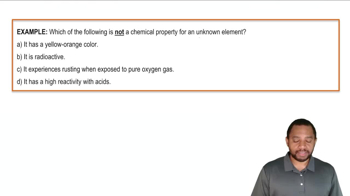Here are the essential concepts you must grasp in order to answer the question correctly.
Chemical Formulas
A chemical formula represents the composition of a compound, indicating the types and numbers of atoms present. For chlorous acid, the formula is HClO2, which shows that it contains one hydrogen atom, one chlorine atom, and two oxygen atoms. Understanding how to derive and interpret chemical formulas is essential for identifying compounds and their properties.
Recommended video:
Oxidation States
The oxidation state, or oxidation number, of an element in a compound indicates the degree of oxidation of that element. It is a theoretical charge that an atom would have if all bonds were ionic. In chlorous acid (HClO2), the oxidation state of chlorine is +3, which can be determined by considering the overall charge of the molecule and the known oxidation states of hydrogen and oxygen.
Recommended video:
Acids and Their Properties
Acids are substances that can donate protons (H+) in a solution, and they often have specific formulas that reflect their composition. Chlorous acid is a weak acid derived from chlorous ion (ClO2-), and its properties, such as acidity and reactivity, are influenced by the presence of the chlorine atom and its oxidation state. Understanding the behavior of acids is crucial for predicting their reactions and applications in chemistry.
Recommended video:
Chemical Properties Example
 Verified step by step guidance
Verified step by step guidance

